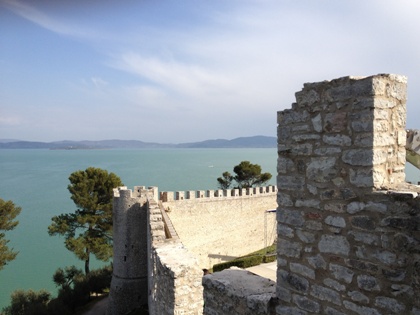
 Vip Weekend- Lake Trasimeno suggested by the famous Art Critic Vittorio Sgarbi
Vip Weekend- Lake Trasimeno suggested by the famous Art Critic Vittorio Sgarbi

filled by Giulia & Romeo

We have the pleasure and honor to inaugurate this new section, Vip Weekend, with Vittorio Sgarbi.
We chose Vittorio Sgarbi as first guest because we value and share his passion for Italy, his continuous search for beauty as well as his democratic conception of art.
Democratic because, as can be seen in his many books, the least of which is Full of Grace (original title Piene di Grazia by Bompiani publisher), beauty is sought wherever, not only behind the most famous names in art history.
While he is leading us to the discovery of the hidden treasures around lake Trasimeno, sitting in our armchair, it feels like before his eyes, and then before ours, is passing a stream of 3D images… with that depth that only passion, knowledge and artistic feeling may confer to words and reality. We thank him for accepting our invitation and for the wonderful weekend he has shared with us between the hills of Umbria.
Giulia & Romeo
“As a starting point, and maybe even overnight, you can take Panicale, a beautiful town built on three floors up the tower of Town Hall, in Masolino square, the highest point of the city, where it could be born the painter Masolino da Panicale, the artist who also worked in Castiglione Olona, Lombardy, and who is also known as a master of Masaccio.
It is a charming medieval town with beautiful churches, where you can admire in particular, in the church of Saint Sebastian, a breathtaking fresco by Perugino, the Martyrdom of Saint Sebastian, with a very airy architecture that opens to the landscape and that somehow reminds, even if in an instrumental way, the landscapes surrounding Panicale.
From Panicale we move to Castiglione del Lago, epicenter of lake Trasimeno, where we find the Corgna Palace, a beautiful building painted mainly by Pomarancio, with mythological and historical frescoes. There it starts a wonderful and covered passageway that leads to the Fortress of the Lion up to a triangular tower that overlooks the lake, a lake so articulated that you can hardly distinguish its boundaries, leaving you the impression of seeing the sea between the hills. After visiting the Palace and the Fortress, you can also take a boat and go to the lake’s islands that have a particular harmony. One is called Maggiore (i.e. Major), with few inhabitants, and the other, private and uninhabited, Minore (i.e. Minor).
From there you can then move to the “places of ill-fame” that are located in the municipal district of Panicale: Mongiovino Vecchia (i.e Old town) and Mongiovino Nuova (i.e. New town). In Mongiovino Vecchia there is a wonderful village, with a landscape that overlooks up to Pietrafitta, which stands right in front, where there are Early Age settlements. In fact, they found skeletons of elephants and mammoths which recently have been collected in a paleontological museum in Pietrafitta.
On one side of Mongiovino you can see the Pietrafitta’s area, on the other you can detect the lake Trasimeno beyond the hills, a wonderful view totally free from construction that has the same linearity of the hills that you can admire in the paintings of Piero della Francesca, a view not to be missed.
Then you go down and reach one of the most beautiful places in Italy, the sanctuary of Mongiovino Nuova, dated 1550-1560. This sanctuary is entirely frescoed and has a structure designed by Rocco da Vicenza, a great architect who also worked in Spello, and who was inspired by the Bramante patterns. Therefore the sanctuary has a central structure similar to that of the Consolation of Todi. But while the Consolation is a very well-known and popular architecture, Mongiovino is totally deserted, hardly visited by any tourist. The sanctuary contains this cycle of interesting frescoes mainly attributed to Pomarancio but also to Lombardelli, a decorative painter mentioned also in my last book.
If then you are lucky enough to find its keys, next to the sanctuary you can see a beautiful sixteenth-century villa with a park full of archeological finds which makes even more spectacular the sight of Mongiovino.
In front of Mongiovino there is the Fortress of Mongiovino Vecchia and you can see the castle of Montenera, a beautiful castle lost in the mountains, which is private. Then you can reach Tuoro, always on lake Trasimeno, where you can feel in the air, in the house where he lived, the memory of a great philosopher whose reissue I have recently supervised, Teodorico Moretti Costanzi.
He was a professor of mine at the University and at the time he was banned by the student revolution being therefore unable to do anything. When he died he left a foundation that is a charming villa overlooking the lake. Today his volume of philosophical and theological writings includes almost his overall work, which contains some beautiful pages of Spinoza and Kierkegaard with some original insights inspired by the catholic thought.
The colors dominating around are every shade of green, a still unspoiled green…
At the top you can see this great valley looking farther to the lake and facing the plain.
Now we go back to Panicale to conclude our tour in Perugia.”
Translated by Anna Bruni http://www.lecicaledifedro.com
Photograph by Francesca di Giorgio
|
|






















